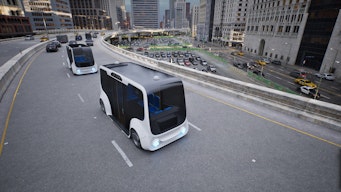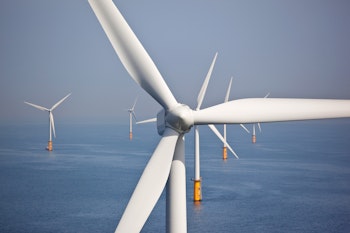Probably the first thing you would notice about the UK’s first five driverless buses is that they each have a driver. Two, in fact. The autonomous Stagecoach service launched in May across the Forth Road Bridge in Edinburgh comes with two staff per bus.
One is at the driver’s seat while the other helps with boarding and buying tickets, according to the BBC. The staff are there presumably to help passengers feel comfortable with the bus driving itself along its 14-mile route, at speeds of up to 50 miles per hour.
In this respect, the scheme is reminiscent of the first days of the automobile industry, when UK lawmakers insisted that vehicles should follow a pedestrian waving a red flag or carrying a lantern.
The UK Locomotives Act of 1865 also ruled that “at least three persons shall be employed to drive or conduct such locomotive, and if more than two waggons or carriages be attached thereto, an additional person shall be employed, who shall take charge of such waggons or carriages.”
These precautions seem ridiculous today, in a world that has been transformed by the massive growth of car ownership and use. It is likely self-driving vehicles could follow the same trajectory, moving rapidly from an oddity that is treated with caution to a key part of our everyday lives.
What will those lives look like, though? A world dominated by self-driving vehicles promises to be safer, more convenient and more efficient. According to the US General Services Administration’s Office of Motor Vehicle Management, 98% of crashes are caused by human error.

This equates to a crash every five seconds, a death every 13 minutes and $230 billion in costs a year—in the US alone. This tragic by-product of car use could be almost eliminated with driverless vehicles, while also helping to reduce traffic—provided rules are in place to discourage ghost trips.
Cities full of driverless vehicles will also be quieter, less polluted and more sustainable because the machines will be electric.
The automotive sector has already set a course towards vehicle electrification, and this is particularly important for autonomous vehicles because of refuelling considerations—imagine a driverless bus trying to fill itself up at a petrol station.
In contrast, electric vehicles could recharge their batteries wirelessly, provided automakers include the technology in their models. Beyond this, the way vehicles interact with the grid will be a key feature of any driverless future.
Grids today are simply not big and strong enough to power the whole of road transport on top of current residential, commercial and industrial loads. Because of this, in April 2023 the National Grid launched the largest overhaul of the UK grid in generations.
The Great Grid Upgrade will see £16 billion being invested in electricity network infrastructure between 2021 and 2026. Alongside this massive investment programme, however, the UK will also need to install at least 50 GW of energy storage by 2050.
This energy storage capacity will ensure there is plentiful power not just for driverless vehicles but for all grid users, whenever and wherever it is needed. It will be key because in future the UK grid will get most of its energy from renewables, and predominantly from offshore wind farms.
The grid is already one of the greenest in the world, with 47% of the 112 GW of generation capacity on the network in 2021 coming from renewables and pumped hydro storage. In the first quarter of 2023, wind became the top source of power on the grid for the first time, beating gas.

Unlike gas, though, wind power cannot be switched on and off to match demand at a given point in time.
Hence, when the wind blows then the electricity it generates needs to be rushed to places where it can be used—which is why National Grid is strengthening the network—or stored for use later.
Lithium-ion battery plants such as the one that Pacific Green is building at Richborough Energy Park in Kent are ideal for this purpose.
While Richborough will, to begin with, make most of its money from helping to manage frequency and voltage on the network, such plants could in theory store up to around six hours of renewable energy that can then be used to prop up the grid when the wind drops.
Autonomous vehicles will rely on these energy stores for refuelling, with both types of assets also taking information from a range of sources—including electricity markets and weather forecasts—to work out optimal charging strategies.
Thus, self-driving cars might put off charging if electricity costs are high or grid supplies are running low. Conversely, during windy periods the vehicles and the battery plants might charge up as fully as possible to take advantage of the availability of cheap, abundant electricity.
Using an early-stage technology called vehicle-to-grid, some of the autonomous vehicles that are not in use on the roads might even lend their own battery capacity to the electricity network in times of energy scarcity.
With most of the UK’s offshore wind farms located far out to sea, and battery plants taking up relatively little room on land, this future might not look too dissimilar to the world we live in today. There will, however, be one fundamental difference.
A planet where self-driving cars have become the norm is likely to be one that is powered by renewable energy, and where the threat of global warming has been overcome.
With scientists now predicting there is a 66% chance society will experience global temperatures more than 1.5 degrees centigrade above pre-industrial levels, with longer heatwaves and more intense storms and wildfires, that threat currently looms larger than ever.
Avoiding it should be at the top of social and political agendas around the world. Looking back in 30 year’s time or so, the idea of drivers in driverless buses might seem quaint---but the moves made to vanquish manmade climate change will likely be remembered in a very different light altogether.
Publish date: 01 December, 2023